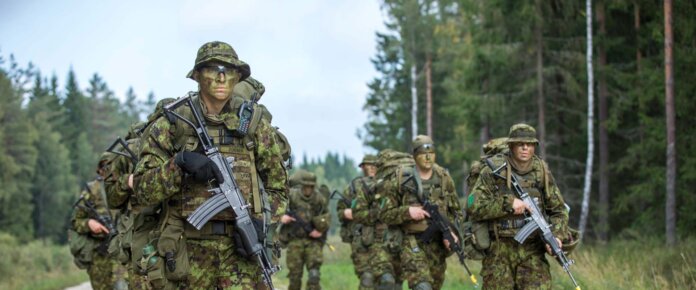
The Estonian government maybe close to selecting a preferred candidate for the next stage of its land forces tactical communications modernisation.
The Estonian Defence Force (EDF) has an existential requirement for new tactical radios to be rolled out across the Estonian Army’s manoeuvre force. The army already possesses L3Harris AN/PRC-117G backpack and AN/PRC-152 handheld radios. The AN/PRC-117G is a 30 megahertz/MHz to three gigahertz/GHz multiband transceiver. Very/Ultra High Frequencies (V/UHF) of 30MHz to 870MHz are covered by the AN/PRC-152. Crucially, both these radios carry the HAVEQUICK and SINCGARS (Single Channel Ground and Airborne Radio System) waveforms. Given that both HAVEQUICK and SINCGARS are used throughout the North Atlantic Treaty Organisation (NATO) the waveforms provide valuable interoperability.
The EDF also uses communications systems provided by Bittium. In 2019, the company was contracted to furnish the Bittium Tough and Tactical Wireless Internet Protocol Network (TAC WIN) systems. The Tough handheld radio uses frequencies of 30MHz to 5.2GHz. TAC WIN, meanwhile, provides a deployable, secure, wireless internet protocol network with achievable data rates of circa 50 megabits-per-second. The Bittium radios support intra-force links within and between manoeuvre units. Despite the acquisitions of the Bittium and L3Harris radios, the Estonian Army’s communications modernisation continues.
Current Plans
Estonia’s Defence Investments 2023-2027 plan articulates ongoing initiatives to overhaul communications capabilities across the EDF. The plan provides circa $1 billion to spend on the acquisition of new communications and radars, with both systems being folded into the same procurement priorities. That said, a budget of $163 million has been made available for further tactical radios: “The objective of the procurement is to provide all units of the Estonian Defence Forces with new and modern … field radios,” says the plan.
The Estonian government has yet to decide on the tactical radios it will procure to satisfy the requirement. Local sources told Armada that the new radios are intended for fielding at platoon level and below. Therefore, they are most likely to be hand-held systems. Estonian land forces doctrine states that an infantry platoon typically covers an area of 120,000 square metres (0.04 square miles). Below the platoon are the squads, with up to five squads of ten troops equipping each infantry platoon. Each squad is composed of two fireteams each with five soldiers with fire teams divided into pairs of troops. It is possible that the new radios will equip squad, platoon and company commanders.
Candidate Systems
Local sources added that transceivers produced by Elbit Systems and Rhode & Schwarz maybe in the running along with Thales. The latter company produces the SYNAPS-H handheld, with the SOVERON-HR possibly forming Rohde & Schwarz’ offering and Elbit potentially promoting the E-Lynx handheld. The sources added that Estonian land forces may also receive the ESSOR waveform for tactical communications in the future. ESSOR is nn abbreviation for the European Secure Software-defined Radio waveform. Its adoption could help deepen Estonian multinational interoperability. Estonia has observer status in the pan-European ESSOR programme alongside the Republic of Ireland. There is no word on when the Estonian government may downselect a preferred design. Nonetheless, sources disclosed that this may happen before the end of the year.
by Dr. Thomas Withington












